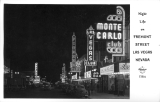Fitzgeralds - at Third and Fremont
This property was originally a mercantile store shortly after the land auction of 1905. It was owned by a couple who spent most of their lives traveling around the Southwest.
In its heart of the community era, Sewell's Market was on this corner and was one of the most successful markets in the downtown area. When Sewell's moved to another location, this became the site of CH Baker Shoes. Next door was Pott's Store for Men.
CH Baker Shoe Ad
CH Baker Shoes was a wonderful store, very popular with showgirls and women who were interested in the fashions of the day. Kids, boys especially, would have there faces pressed against the glass looking at the glamourous women trying on shoes.
In 1971, CH Baker and Potts Mens Store were closed and the property became an office building. Next door were Schwartz Brothers Mens Wear (I guess guys still needed more mens stores back then), Zale's Jewelers, the Silver Dollar Trading Post, a McDonald's and a Thrifty Drugs.
Before it was a McDonalds, that property was the Hickory Wood Pit BBQue which had roasting chickens in the window. Old timers still fondly remember that smell.
In 1937, JC Penney's had a store and catalogue department at 319 Fremont Street. It was an old brick building (still is) with a second floor. Old timers remember the second floor was where the change was made. Pneumatic tubes ran from the second floor to the check out counters and sales clerks would take your money, put it in the tube with your bill, press the button and the tube would carry your money upstairs where change was made and the tube sent back down to the counter. Penney's later moved further east on Fremont where the Fremont Medical Building is today.
When Penney's moved, the property likely became Thrifty Drugs. The second floor was where large items such as furniture were sold, a rather novel idea fordrug stores in todays' way of thinking. Today, it is Tiffany's Souvenir Shop.
Tiffany's Souvenirs Gifts
Next to Tiffany's on the western corner of Fourth and Fremont today sits the Western Village with a gold rush miner on the roof. This originally was Indian Joe's Souvenirs and Western Indian Wear. Next door was Franklin's Women's Wear in a small building but it made up in length what it lacked in width.
In 1979, the Sundance Casino opened on the corner. In 1987, it became Fitzgerald's and the mascot was a leprechaun known as Mr. Lucky. When the hotel rebranded itself a few years ago, Mr. Lucky was sent to the Neon boneyard. While in the boneyard, he met with an unfortunate fire of suspicious nature and was badly damaged.
Special thanks to Allen Sandquist!








